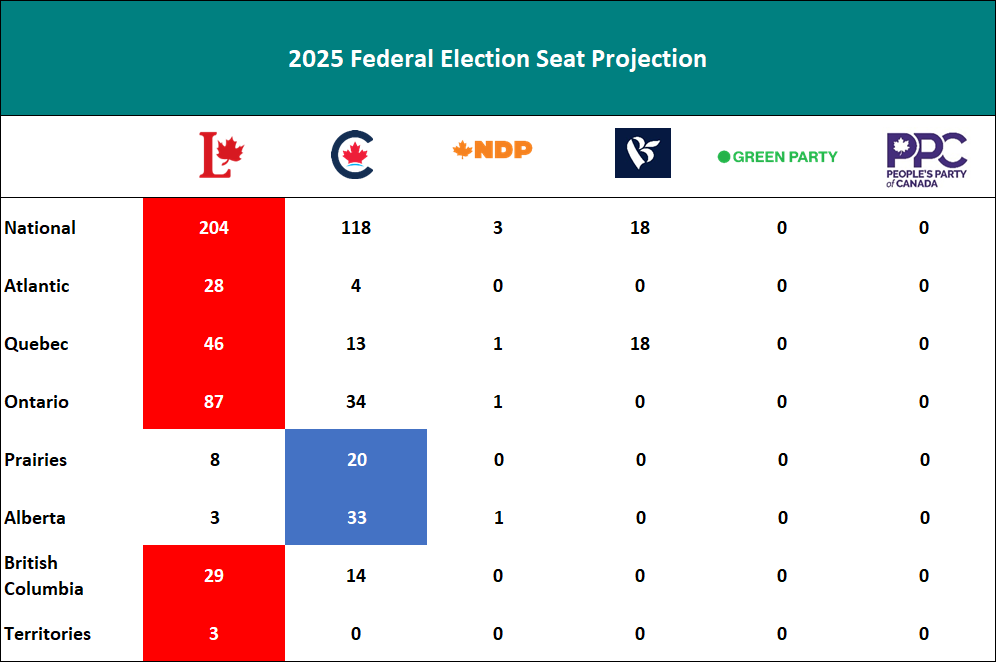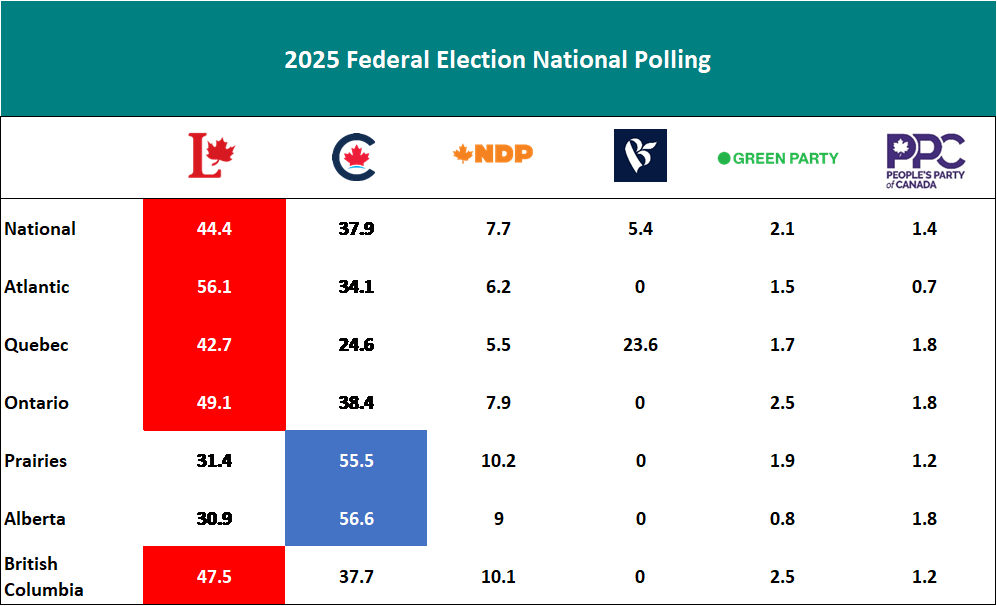By: Brian Klunder, Senior Counsel
With two weeks before Election Day, campaigns are moving from voter identification to ensuring their voters begin voting in advance polls over Easter weekend, from April 18 – April 21.
The goal is to lock in these votes. Each advance poll voter is one less who needs to be pulled out to vote on April 28th and one less who can change their voter intention or choose not to vote entirely. Preparing for advance polls will be the dominant theme for many campaigns this week.
For national campaigns, the focus will be on debates on Wednesday, April 16th (French) and Thursday, April 17th (English). Before the debates, we may also see platforms released in full. While both will be discussed in detail by media and political watchers, we must see if either moves votes.
This leads us to my weekly check-in on the state of the race and what my model is currently projecting in terms of seat count. I’ve also chosen to look at the closest races in each region based on my current projection and polling average. With campaigns moving to a focus on “Get Out the Vote” (GOTV), organization in ensuring voter turnout in advance polls and on Election Day will be crucial and can be critical difference-makers in a close race.
Seat Projection (majority requires 172 seats)
I have small changes at the top in this week’s seat projection. The Liberals lead with 204 (up from 202 last week) seats – as they move ahead in the current NDP seats – London—Fanshawe (ON), Churchill—Keewatinook Aski (MB), and Vancouver East (BC). The Conservatives are at 118 (up from 116) as they take another NDP seat in Elmwood—Transcona. This leaves the NDP down to only three seats, while the Bloc remains at 18. I do not have the Green Party winning a single seat in this projection.
In the model, the Liberal Party is dominant in Ontario, Quebec and Atlantic Canada – winning 161 of their projected 204 seats in these regions. They are also projected to win at least one seat in each province or territory. Pierre Poilievre is dominant in Alberta and the Prairies but must close the gap between Liberal and Conservative support in Ontario and, to a lesser extent, British Columbia. In both those Provinces, the Conservatives enjoy significant levels of support, however, the NDP vote has collapsed in both those Provinces and gravitated to the Liberals. In fact, the Conservatives are currently polling ahead of their 2021 vote totals in both Ontario and British Columbia.
With close races across the country and polls continuing to show varied outcomes, this race could still change significantly; it is far too early for Liberal partisans to begin celebrating—especially knowing the Conservative Party’s strong GOTV, which can deliver results in close races.

Ridings to Watch
This week, we are looking at some of the closest races across Canada, races in which getting voters to the polls will make a crucial difference between winning and losing.
Atlantic
Miramichi—Grand Lake —This northeastern New Brunswick riding has elected Liberal and Conservative MPs. Mike Dawson has replaced Jake Stewart as the Conservative candidate in Miramichi—Grand Lake after tensions arose with the incumbent Conservative MP and the Electoral District Association. Dawson is now facing a tighter-than-expected race with former Liberal provincial MLA, Lisa Harris.
Acadie—Annapolis — Located in Western Nova Scotia, this is a newly constructed riding through redistribution. Chris d’Entremont has been in the House of Commons since 2019 (representing West Nova) and, while the race is close, he looks like he can hold on.
Quebec
Berthier—Maskinongé — With former NDP MP Ruth Ellen Brosseau running again, this rural riding has a close three-way race and is one to watch as we enter the home stretch.
Saint-Jean — Lying between Montreal and the U.S. border this riding has often been a battleground between the Bloc Québécois, and the Liberal Party. Currently, the Bloc holds it, but it appears the Liberal Party is ahead with two weeks to go.
Terrebonne — Lying north of Montreal, this is a riding the Bloc Québécois would hate to lose. With their ongoing drop in the polls, Terrebonne is in play with the Liberals currently in front.
Ontario
Hamilton Centre — This NDP seat is at risk against the Liberal surge. We’ll have to see if incumbent MP Matthew Green has enough personal appeal to win the seat again.
London—Fanshawe — Another NDP seat facing a close race. The Liberals and NDP are fighting tooth and nail for this, but the Conservatives are also within striking distance.
Markham—Unionville — With the current MP pulling himself out in controversy and a last-minute replacement filling the candidacy for the Liberals, the Conservatives are positioned to pick up this critical 905 seat in an extremely close race.
Northumberland—Clarke — This largely rural seat east of the GTA has been constructed from Northumberland-Peterborough South and Durham. The race is very close, with the Conservatives holding a very small lead over the Liberals.
Prairies
Churchill—Keewatinook Aski — This seat encompasses Northern Manitoba and has been held by the NDP and MP Nikki Ashton since 2008. The Liberals see a chance to win this seat, but the race is extremely close.
Elmwood—Transcona — The NDP held off the Conservatives in a 2024 by-election in this blue-collar Winnipeg constituency. It is not clear if they can repeat in 2025. The riding has a long NDP tradition and was represented by Bill and Daniel Blaikie. But the winds may have shifted, and the Conservatives are well-positioned to pick up this seat.
Alberta
Calgary Centre — Greg MacLean has been the Conservative MP for Calgary Centre since 2019, but the Liberals are threatening. Losing this seat in Calgary would hurt both MacLean and Pierre Poilievre.
British Columbia
Courtenay—Alberni — This Vancouver Island seat has turned into a race between the Liberal and Conservative candidates, with the incumbent NDP sitting in third. It will come down to the wire.
Langley Township—Fraser Heights — The return of former Liberal MP John Aldag is making this an interesting race in a newly formed riding. At this point in the race, we see the Liberals and the Conservatives in a coin-toss fight.

National Polling Average (%)
We are still seeing a big range in polling results with one (Mainstreet) now showing a small Conservative lead and others showing a larger spread with the Liberals in front. I’d expect things to become much clearer over the next week and we will know if the gap is closing or if Mark Carney and the Liberal Party are on the cusp of a large majority.
I have the Liberal Party at 44.4% in my polling average (the same as last week) while the Conservatives have come up from 36.8% to 37.9% this week. The NDP is down to 7.7% (from 8.4% last week) while the Bloc is at 5.4% (23.6% in Quebec). Both the Greens and PPC are languishing in low single digits.

What It Means
With GOTV now the dominant consideration for riding-level campaigns, the national campaigns will look to strengthen their vote and enter Easter weekend with momentum. I believe this race remains fluid. The Conservatives have a very short track to turn things around, but they have a path. This week’s debates will be consequential, and each party’s ability to begin turning out their vote will be absolutely critical – especially in the close races outlined here.
Methodology – The TSA Seat projection is calculated based on national polls taken over the previous week. Each riding result is based on the results of the 2019 and 2021 elections and transposed to the new seat boundaries. Thanks to the work Phillipe Fournier has done at 338Canada to transpose votes for both 2019 and 2021. Riding results are compared to regional results in 2019 and 2021 to calculate a projected result for each riding.

